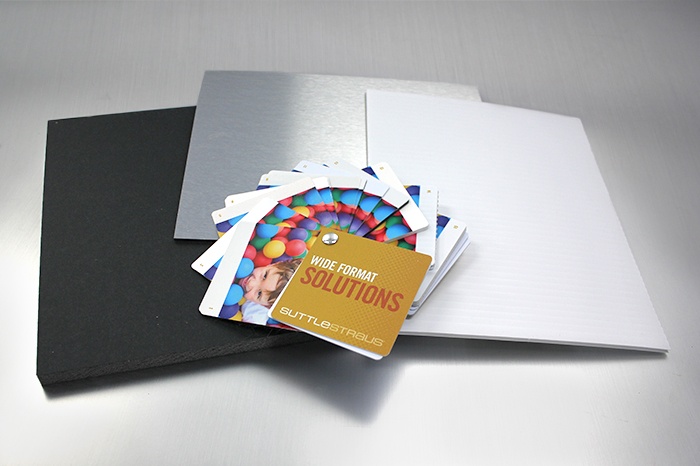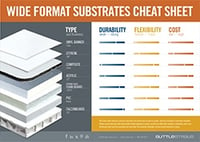
When it comes to printing your wide format project, selecting the appropriate substrate can be the key to its success. Image quality, layout and messaging all have a significant impact on a sign’s performance, but so does the material it’s printed on. With all the unique substrates available in the wide format market, there is bound to be one that works with your project and will create the desired end result. However, because there are literally thousands of options, selecting the right substrate can be challenging. You should take three main items into consideration when selecting a wide format substrate.
Budget
Substrates can range significantly in costs, so whether you’re operating on a conservative or robust budget, finding something that fits your needs should be achievable. If you are on a tight budget, more economy based products such as paper, corrugate based falcon board, scrim banner, or coroplast boards can be used. Each of these substrates has another subset of properties, which opens up many possibilities while keeping your material costs low. If you are operating on a budget that supports a higher end look, consider material like acrylic, metalized dibond, such as bronze or aluminum finishes, or black PVC boards, utilizing white ink. Choosing the right substrate for your application and budget will provide you the results you desire.
Environment
Understanding the environment your project will live in is also important. Giving consideration to outdoor versus indoor applications can affect the substrates available for your project. Outdoor applications will limit the substrates to those that are weather resistant so they can withstand conditions such as heat, cold, rain, and sun. While outdoor substrates can typically be used indoors as well, indoor substrates have attributes that limit their use in outdoor environments. These items are typically designed to only last under controlled environments that aren’t exposed to extreme temperatures or moisture. In both indoor and outdoor applications, premium and economy substrates can often be available.
Application
The application goal will be one of the key determining factors in the substrate that is chosen. Consider factors such as the duration that the application will live. For example, if you are doing a wall mural, will it be a long-term, permanent application? Or, are you looking for a shorter duration? With either scenario, material selection and cost will be impacted by the duration. The mural could be printed on traditional wallpaper that is glued to the wall. This would provide it longevity, but it’s not flexible and cost effective to replace in the short or medium term. Adhesive vinyl can be used for a more medium term solution, and is easier to remove. Knowing your application duration can greatly assist in pointing to the right substrate.
 If you need help determining which substrates would be a good fit for your project, download our free infographic, Wide Format Substrates Cheat Sheet or contact your sales representative for samples of key substrates. Often the best way to understand how the material would apply to your project is to touch and feel it.
If you need help determining which substrates would be a good fit for your project, download our free infographic, Wide Format Substrates Cheat Sheet or contact your sales representative for samples of key substrates. Often the best way to understand how the material would apply to your project is to touch and feel it.



